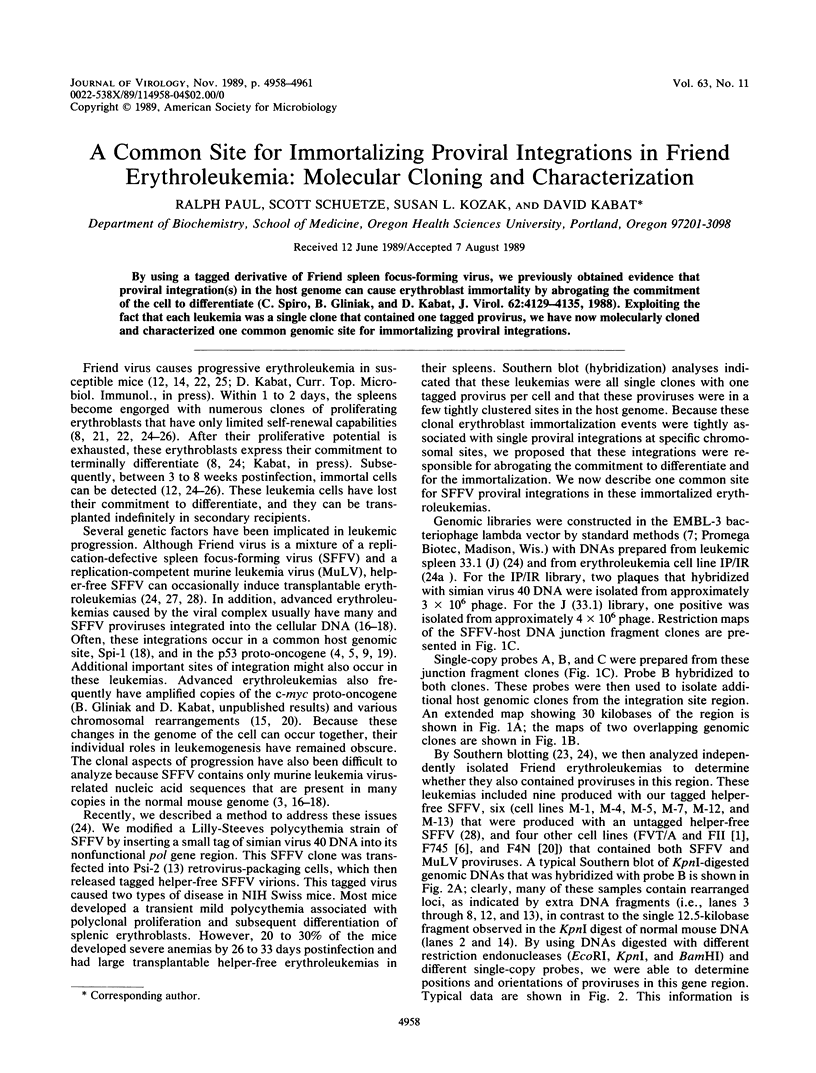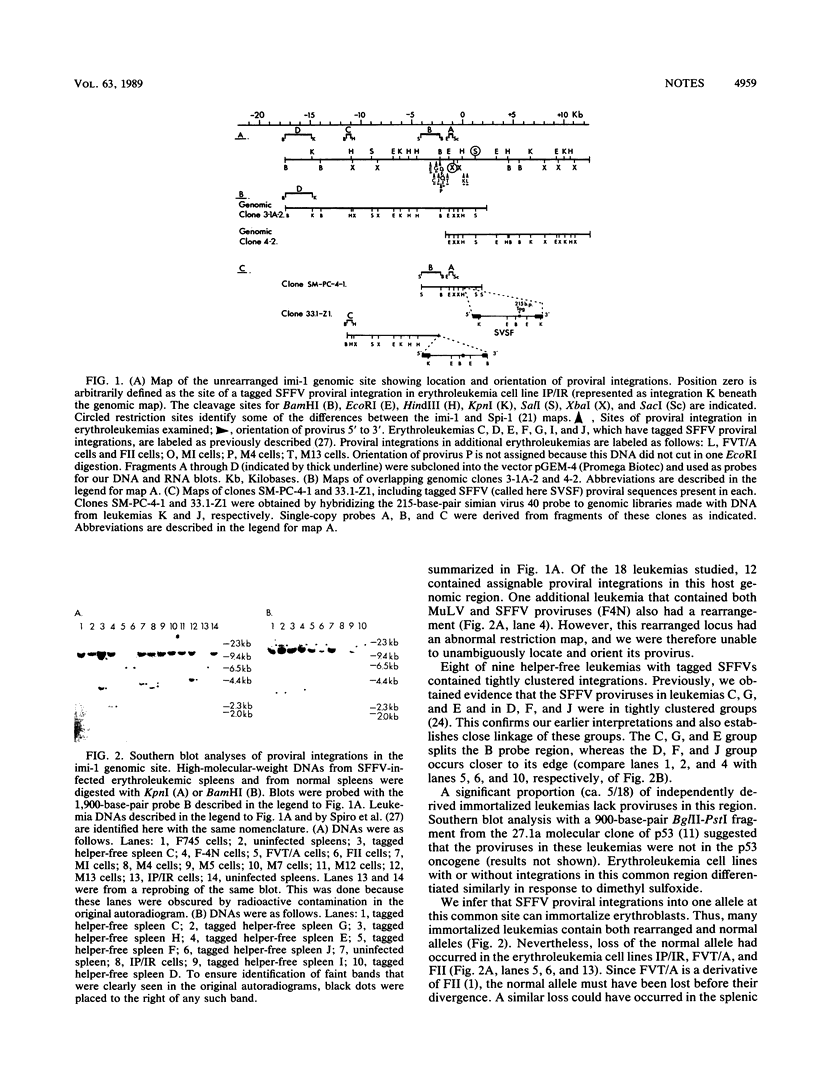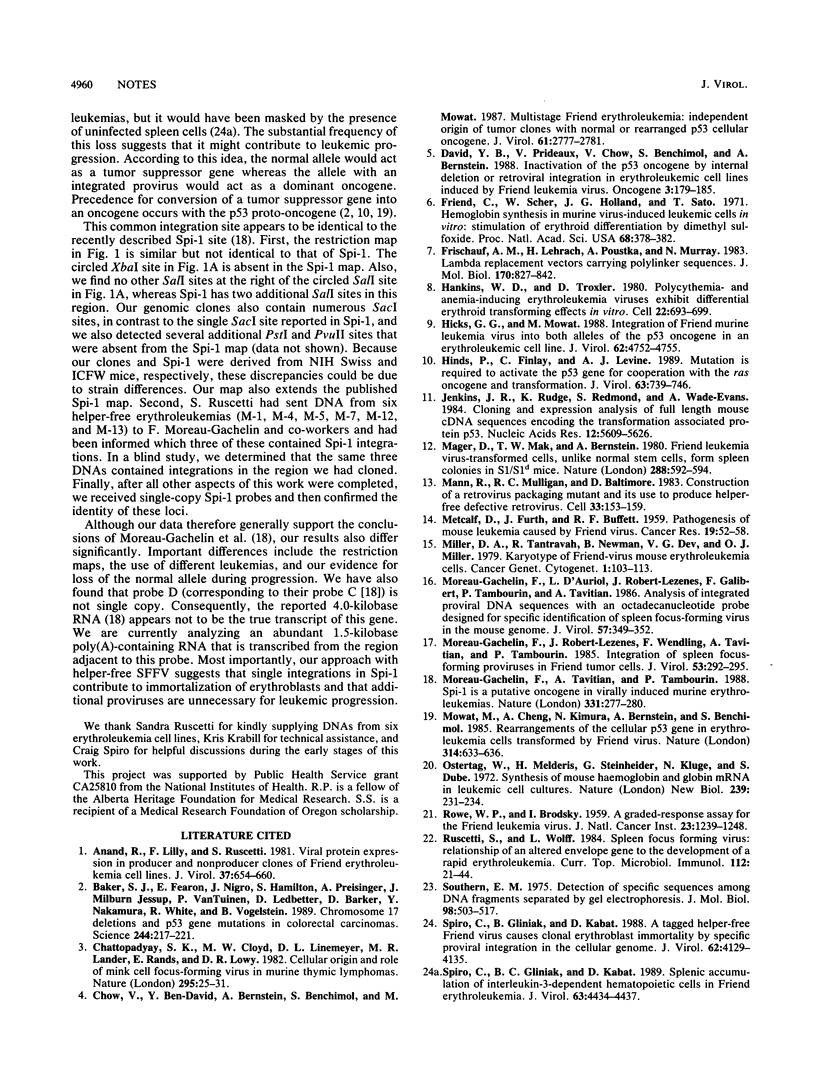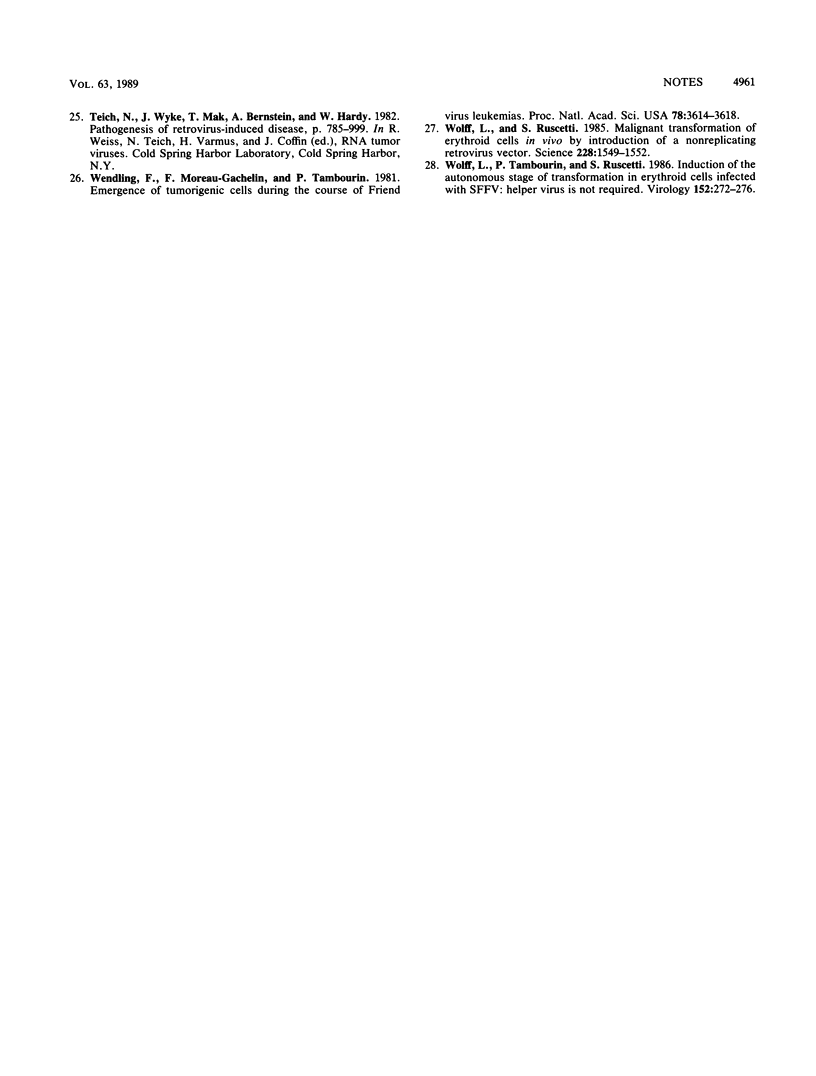Abstract
By using a tagged derivative of Friend spleen focus-forming virus, we previously obtained evidence that proviral integration(s) in the host genome can cause erythroblast immortality by abrogating the commitment of the cell to differentiate (C. Spiro, B. Gliniak, and D. Kabat, J. Virol. 62:4129-4135, 1988). Exploiting the fact that each leukemia was a single clone that contained one tagged provirus, we have now molecularly cloned and characterized one common genomic site for immortalizing proviral integrations.
Full text
PDF



Images in this article
Selected References
These references are in PubMed. This may not be the complete list of references from this article.
- Anand R., Lilly F., Ruscetti S. Viral protein expression in producer and nonproducer clones of friend erythroleukemia cell lines. J Virol. 1981 Feb;37(2):654–660. doi: 10.1128/jvi.37.2.654-660.1981. [DOI] [PMC free article] [PubMed] [Google Scholar]
- Baker S. J., Fearon E. R., Nigro J. M., Hamilton S. R., Preisinger A. C., Jessup J. M., vanTuinen P., Ledbetter D. H., Barker D. F., Nakamura Y. Chromosome 17 deletions and p53 gene mutations in colorectal carcinomas. Science. 1989 Apr 14;244(4901):217–221. doi: 10.1126/science.2649981. [DOI] [PubMed] [Google Scholar]
- Ben David Y., Prideaux V. R., Chow V., Benchimol S., Bernstein A. Inactivation of the p53 oncogene by internal deletion or retroviral integration in erythroleukemic cell lines induced by Friend leukemia virus. Oncogene. 1988 Aug;3(2):179–185. [PubMed] [Google Scholar]
- Chattopadhyay S. K., Cloyd M. W., Linemeyer D. L., Lander M. R., Rands E., Lowy D. R. Cellular origin and role of mink cell focus-forming viruses in murine thymic lymphomas. Nature. 1982 Jan 7;295(5844):25–31. doi: 10.1038/295025a0. [DOI] [PubMed] [Google Scholar]
- Chow V., Ben-David Y., Bernstein A., Benchimol S., Mowat M. Multistage Friend erythroleukemia: independent origin of tumor clones with normal or rearranged p53 cellular oncogenes. J Virol. 1987 Sep;61(9):2777–2781. doi: 10.1128/jvi.61.9.2777-2781.1987. [DOI] [PMC free article] [PubMed] [Google Scholar]
- Friend C., Scher W., Holland J. G., Sato T. Hemoglobin synthesis in murine virus-induced leukemic cells in vitro: stimulation of erythroid differentiation by dimethyl sulfoxide. Proc Natl Acad Sci U S A. 1971 Feb;68(2):378–382. doi: 10.1073/pnas.68.2.378. [DOI] [PMC free article] [PubMed] [Google Scholar]
- Frischauf A. M., Lehrach H., Poustka A., Murray N. Lambda replacement vectors carrying polylinker sequences. J Mol Biol. 1983 Nov 15;170(4):827–842. doi: 10.1016/s0022-2836(83)80190-9. [DOI] [PubMed] [Google Scholar]
- Hankins W. D., Troxler D. Polycythemia- and anemia-inducing erythroleukemia viruses exhibit differential erythroid transforming effects in vitro. Cell. 1980 Dec;22(3):693–699. doi: 10.1016/0092-8674(80)90545-0. [DOI] [PubMed] [Google Scholar]
- Hicks G. G., Mowat M. Integration of Friend murine leukemia virus into both alleles of the p53 oncogene in an erythroleukemic cell line. J Virol. 1988 Dec;62(12):4752–4755. doi: 10.1128/jvi.62.12.4752-4755.1988. [DOI] [PMC free article] [PubMed] [Google Scholar]
- Hinds P., Finlay C., Levine A. J. Mutation is required to activate the p53 gene for cooperation with the ras oncogene and transformation. J Virol. 1989 Feb;63(2):739–746. doi: 10.1128/jvi.63.2.739-746.1989. [DOI] [PMC free article] [PubMed] [Google Scholar]
- Jenkins J. R., Rudge K., Redmond S., Wade-Evans A. Cloning and expression analysis of full length mouse cDNA sequences encoding the transformation associated protein p53. Nucleic Acids Res. 1984 Jul 25;12(14):5609–5626. doi: 10.1093/nar/12.14.5609. [DOI] [PMC free article] [PubMed] [Google Scholar]
- METCALF D., FURTH J., BUFFETT R. F. Pathogenesis of mouse leukemia caused by Friend virus. Cancer Res. 1959 Jan;19(1):52–58. [PubMed] [Google Scholar]
- Mager D., Mak T. W., Bernstein A. Friend leukaemia virus-transformed cells, unlike normal stem cells, form spleen colonies in Sl/sld mice. Nature. 1980 Dec 11;288(5791):592–594. doi: 10.1038/288592a0. [DOI] [PubMed] [Google Scholar]
- Mann R., Mulligan R. C., Baltimore D. Construction of a retrovirus packaging mutant and its use to produce helper-free defective retrovirus. Cell. 1983 May;33(1):153–159. doi: 10.1016/0092-8674(83)90344-6. [DOI] [PubMed] [Google Scholar]
- Moreau-Gachelin F., D'Auriol L., Robert-Lezenes J., Galibert F., Tambourin P., Tavitian A. Analysis of integrated proviral DNA sequences with an octadecanucleotide probe designed for specific identification of spleen focus-forming virus in the mouse genome. J Virol. 1986 Jan;57(1):349–352. doi: 10.1128/jvi.57.1.349-352.1986. [DOI] [PMC free article] [PubMed] [Google Scholar]
- Moreau-Gachelin F., Robert-Lezenes J., Wendling F., Tavitian A., Tambourin P. Integration of spleen focus-forming virus proviruses in Friend tumor cells. J Virol. 1985 Jan;53(1):292–295. doi: 10.1128/jvi.53.1.292-295.1985. [DOI] [PMC free article] [PubMed] [Google Scholar]
- Moreau-Gachelin F., Tavitian A., Tambourin P. Spi-1 is a putative oncogene in virally induced murine erythroleukaemias. Nature. 1988 Jan 21;331(6153):277–280. doi: 10.1038/331277a0. [DOI] [PubMed] [Google Scholar]
- Mowat M., Cheng A., Kimura N., Bernstein A., Benchimol S. Rearrangements of the cellular p53 gene in erythroleukaemic cells transformed by Friend virus. Nature. 1985 Apr 18;314(6012):633–636. doi: 10.1038/314633a0. [DOI] [PubMed] [Google Scholar]
- Ostertag W., Melderis H., Steinheider G., Kluge N., Dube S. Synthesis of mouse haemoglobin and globin mRNA in leukaemic cell cultures. Nat New Biol. 1972 Oct 25;239(95):231–234. doi: 10.1038/newbio239231a0. [DOI] [PubMed] [Google Scholar]
- ROWE W. P., BRODSKY I. A graded-response assay for the Friend leukemia virus. J Natl Cancer Inst. 1959 Dec;23:1239–1248. [PubMed] [Google Scholar]
- Ruscetti S., Wolff L. Spleen focus-forming virus: relationship of an altered envelope gene to the development of a rapid erythroleukemia. Curr Top Microbiol Immunol. 1984;112:21–44. doi: 10.1007/978-3-642-69677-0_2. [DOI] [PubMed] [Google Scholar]
- Southern E. M. Detection of specific sequences among DNA fragments separated by gel electrophoresis. J Mol Biol. 1975 Nov 5;98(3):503–517. doi: 10.1016/s0022-2836(75)80083-0. [DOI] [PubMed] [Google Scholar]
- Spiro C., Gliniak B. C., Kabat D. Splenic accumulation of interleukin-3-dependent hematopoietic cells in Friend erythroleukemia. J Virol. 1989 Oct;63(10):4434–4437. doi: 10.1128/jvi.63.10.4434-4437.1989. [DOI] [PMC free article] [PubMed] [Google Scholar]
- Spiro C., Gliniak B., Kabat D. A tagged helper-free Friend virus causes clonal erythroblast immortality by specific proviral integration in the cellular genome. J Virol. 1988 Nov;62(11):4129–4135. doi: 10.1128/jvi.62.11.4129-4135.1988. [DOI] [PMC free article] [PubMed] [Google Scholar]
- Wendling F., Moreau-Gachelin F., Tambourin P. Emergence of tumorigenic cells during the course of Friend virus leukemias. Proc Natl Acad Sci U S A. 1981 Jun;78(6):3614–3618. doi: 10.1073/pnas.78.6.3614. [DOI] [PMC free article] [PubMed] [Google Scholar]
- Wolff L., Ruscetti S. Malignant transformation of erythroid cells in vivo by introduction of a nonreplicating retrovirus vector. Science. 1985 Jun 28;228(4707):1549–1552. doi: 10.1126/science.2990034. [DOI] [PubMed] [Google Scholar]
- Wolff L., Tambourin P., Ruscetti S. Induction of the autonomous stage of transformation in erythroid cells infected with SFFV: helper virus is not required. Virology. 1986 Jul 15;152(1):272–276. doi: 10.1016/0042-6822(86)90393-4. [DOI] [PubMed] [Google Scholar]



